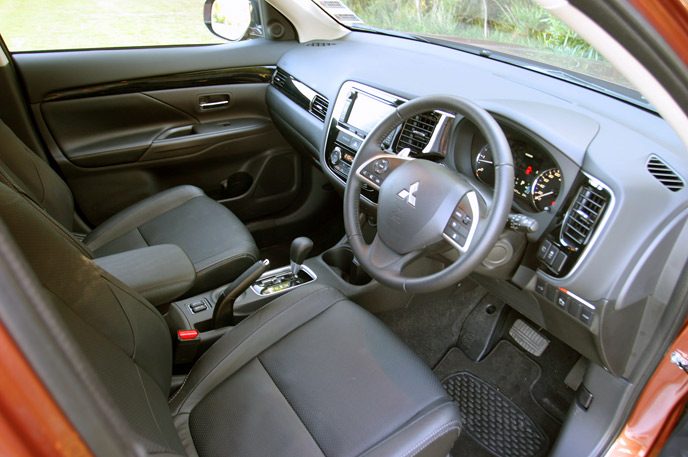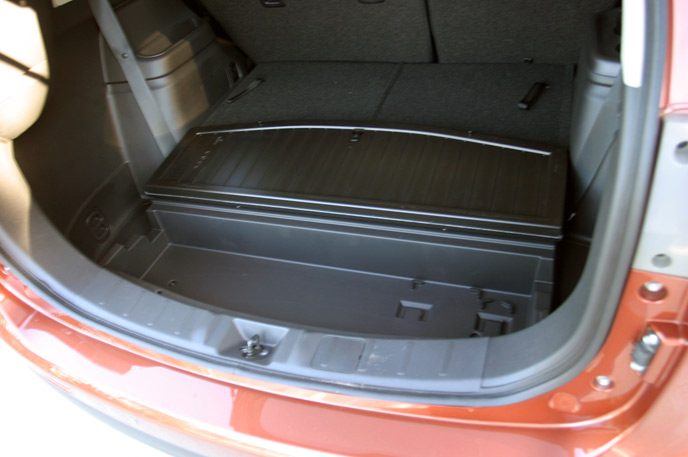Mitsubishi Outlander VRX 4WD 7-seat 2013 new car review
The seven seat Outlander has been up at the pointy end of the pack for a while now.

The seven seat Outlander has been up at the pointy end of the pack for a while now. In fact, a year ago we reviewed the XLS version and our only gripes were the interior and the dull colour range.
Enter the 2013 Outlander…in a kind of brown, which is a colour that should have been left with Mark II Cortinas in the 80s. OK, it’s kind of coppery, almost burnt orangey-brown, but my personal preference is any one of the other colours for this top-of-the-line Outlander.
There’s a significant redesign on the outside which looks good from the three-quarter angles of the front and rear, but a little unbalanced with a bulbous rear from the side despite having substantial 18-inch alloys that wear 225/55R18 tyres.
The angular, aggressive design of the previous model has given way to a more rounded form with a strong grille design reminiscent of a Transformers logo. The overall design has made the Outlander look a little more generic, but it has improved the coefficient of drag to 0.33, which undoubtedly helps the fuel economy.
- Excellent diesel engine
- Excellent warranty options (up to 10 years and 160,000)
- Quiet, spacious cabin
- The ride is now too soft and it makes the steering feel less precise
- Doesn’t look as balanced as the previous model
- Seats lack lumbar support adjustment
On the road
New construction methods and a more rigid body shell allow for thinner body panels. Add to this a set of lightweight alloy wheels and the overall weight has shed 20kg, despite extra features. This means less mass and resistance for the new 2.2-litre turbo diesel engine to shift. Mitsubishi claims 5.8l/100km on the open road not using the optional eco control, and that is impressive for a vehicle this size. My journey from Auckland to Tinopai via SH16 averaged 6.8l/100km.
The towing abilities are modest at only 2000kg, despite four-wheel drive and the torquey diesel engine (224Nm and 126kW for the petrol and 112kW and 366Nm for the diesel) – you’ll need to move up to the Pajero if you want more off-road and hauling power. There are three 4WD modes: 4WD eco (which is 2WD unless you need the grip), 4WD auto and 4WD lock, which is useful for really rough surfaces.
Overtaking seemed easy; SUVs pulling boats at 90kph were dispatched efficiently. Back on the motorway you can use the adaptive cruise control which, by using a radar system, adjusts your speed to the car in front if you catch up with it. It also tells you to brake if it detects someone slowing suddenly in your lane. If you don’t brake, it will. This system (FCM – Forward Collision Mitigation) seemed a little trigger happy, particularly in the city, so I ended up disabling it.
Inside and out
The interior of the XLS is very well-appointed. The leather seats are comfortable, despite not offering adjustable lumbar support. The driving position is excellent with good visibility all around.
The multimedia system supports Bluetooth streaming phone your phone (including phone call integration), and the usual set of discs and other media. Controls for this are predominantly using the touchscreen, but there are buttons on the steering wheel for basic operations.
As per most large SUVs these days, a 5-star ANCAP safety rating is standard and it comes with antilock brakes, Active Stability Control, Active Traction Control, Electronic Brake Force Distribution, Hill Start Assist and seven airbags.
Boot space is slightly less than the previous model with the second row of seats down and the boot doesn’t have the split tailgate. Some people have said they love the split tailgate because it provides options for sitting on it, etc, but I personally prefer the new single tailgate because the floor is flush with the boot aperture, so you can still sit on there if needed.
There’s a useful area under this floor which serves as either hidden storage for valuable when the rear seats are up and the cargo blind can’t be used, or it stores the cargo blind itself, while still leaving a little room for other items. This is a good improvement over the previous model which was not satisfactory in this area. The tailgate itself can be opened remotely and closed by pushing a button.
While Mitsubishi has improved the interior dramatically, the new Outlander seems to be a softer ride than the outgoing one – perhaps a little too soft – and this makes the steering feel imprecise if you’re trying to hustle it along.
On the Auckland to Tinopai jaunt, which took in some sinuous tarmac for the last half an hour of the journey, I found myself concentrating a little too hard to hit the corner apexes. I’m a little bit more obsessive about that than most other drivers will be, but hitting the apex is the smoothest way around the corner and that’s good for passengers.
Overall
While my personal preference is for something a little more precise, you can’t fault the Outlander’s overall ride comfort for general cruising. It had plenty of room to fit our extensive luggage on the way up to the bach, and did double duty transporting six of us from the beach (including putting a 6’3” friend in the third row just to see how cramped it was…it’s definitely not designed for people that tall).
As a seven seat vehicle it’s going to serve your practical needs. The third row of seats is much easier to erect in this Outlander than the old version which required a detailed instruction panel for you to make sense of it. Something as easy as putting a seat up shouldn’t require instructions at all – if it does, the process is broken. Therefore, Mitsubishi has fixed that as well as addressing the overall cabin experience.
The diesel looks like the model to go for, but it comes at a premium. There are petrol models available (2-litre and 2.4-litre, both mated to a CVT gearbox) that start at $38,990. Our tested model was the top spec VRX and is $56,990.
Note: this was reviewed as a new vehicle.
Image gallery
Also consider






